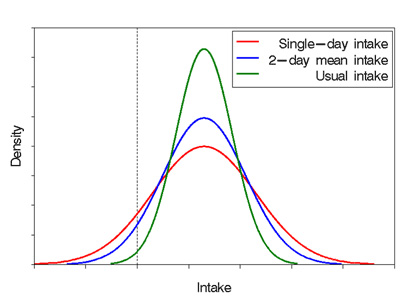Learn More about Usual Dietary Intake
Usual dietary intake refers to the long-run average or habitual daily intake of a nutrient or food. This concept is relevant to many nutrition studies because dietary recommendations are intended to be met over time, diet-health hypotheses are based on dietary intakes over the long term, and interventions are intended to affect habitual diet. Consequently, it is usual intake that is often of most interest to policy makers—when they want to know the proportion of the population at or below a certain level of intake—or to researchers—when they want to examine relationships between dietary exposures and health [glossary term:] outcomes or assess the effect of an intervention on dietary outcomes.
Food frequency questionnaires (FFQs) and screeners (see Food Frequency Questionnaire Profile and Screeners Profile) attempt to measure [glossary term:] usual dietary intake directly by asking about consumption over an extended period of time, but do so with an appreciable amount of [glossary term:] bias (see Key Concepts about Measurement Error). Twenty four-hour dietary recalls (24HRs) are considered among the most accurate (least biased) methods of assessing diet (see 24-hour Dietary Recall Profile). However, any [glossary term:] short-term instrument, such as a single 24HR or a food record (see Food Record Profile) represents only a "snapshot in time" and one, or even a few, does not represent a person's average daily intake. In fact, for many dietary constituents (especially those consumed [glossary term:] episodically rather than daily), there is greater [glossary term:] within-person variation (also referred to as [glossary term:] day-to-day variation), a source of [glossary term:] within-person random error), than there is between persons within a population.
This limitation—excessive within-person variation in data from short-term dietary instruments—does not affect the estimated [glossary term:] mean usual intake for a group, but it can lead to serious problems in interpreting other types of estimates. For example, the distribution of single-day intakes has a larger variance than the true usual intake distribution. This means that using a single recall—or even the average of two—leads to a biased estimate of the fraction of the population with usual intake above or below some standard (that is, in the tails of the distribution).

Another problem relates to the interpretation of regression analyses for examining diet-disease relationships, in which all types of dietary [glossary term:] measurement error generally lead to biased estimation and a loss of statistical [glossary term:] power, and may invalidate statistical tests. The excessive day-to-day variation inherent in 24HRs contributes to within-person random error that leads to [glossary term:] attenuation. Other types of measurement error involved in the assessment may attenuate or exaggerate the relationship, but generally the net effect is attenuation (see Key Concept about Measurement Error).

Fortunately, statistical modeling can be used to mitigate this limitation of 24HRs (Learn More about Statistical Modeling). This requires repeat, preferably non-consecutive, recalls on at least a portion of a sample, with the number of repeats needed dependent on how regularly a given dietary component is consumed by most members of the population. The number of recalls and the sample size are important considerations in designing a study to obtain reliable group-level estimates of usual intake, particularly for episodically-consumed components (Learn More about Deriving Group-level Estimates from Individual-level Intakes). For more information on this topic, see Choosing an Approach for Dietary Assessment.
Assessment of usual intake does not necessarily refer to a set period of time, as habitual patterns of eating can be of varying lengths. For example, an omnivore who suddenly switches to becoming a vegan can be thought of as having two different "usual" intakes, one leading up to the change and the other following. For some types of studies, it may be important to try to capture usual intake for these different periods, whereas for other studies, it may be preferential to have a sense of average cumulative exposure. Usual intakes can only be estimated for the period for which data have been captured.
